Jennifer Bohnhoff's Blog, page 5
January 26, 2025
The Lindenmeier Site

The Soapstone Prairie Natural Area is in central Colorado, just south of the Wyoming border. It has within it an archeological site that few know about, even though it is very important to our understanding of man in the Americas. The Lindenmeier Folsom Site is one of the hidden gems of American Prehistory.
 point from the Lindenmeier Site, 1934Folsom Man is the name given to a group of Paleo-Indian nomadic hunters who roamed throughout Central North America between approximately 9,000 BC and 4,000 BC. They are identified by their stone points, which have a distinct concavity on one side.
point from the Lindenmeier Site, 1934Folsom Man is the name given to a group of Paleo-Indian nomadic hunters who roamed throughout Central North America between approximately 9,000 BC and 4,000 BC. They are identified by their stone points, which have a distinct concavity on one side.Folsom Man is named after the small town of Folsom, New Mexico, In 1908, a devastating flood unearthed bison bones that were exceedingly large. It wasn’t until 1925, when scientists finally investigated the site, that stone points were found with the bones. The bones were determined to be those of bison antiquus, an ancestor of the modern bison that had died out approximately 10,000 years ago.
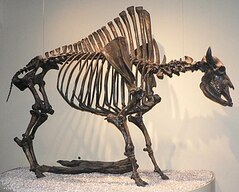 Bison Antiquus. They were 25-30% larger than present day bison. Prior to the investigation of the Folsom Site, scientists believed that man had only been in North America for approximately 5,000 years.
Bison Antiquus. They were 25-30% larger than present day bison. Prior to the investigation of the Folsom Site, scientists believed that man had only been in North America for approximately 5,000 years. The Folsom Site is just a kill site. It contains bones and stone points, but there is no evidence of habitation, no campfires, no other tools or implements. Although it proved that man was in the Americas much earlier than previously supposed, it shed little light on who these people were.
 Working at the site with horses 1936
Working at the site with horses 1936In 1924, three amateur archaeologists, A. Lynn Coffin, his father, Judge Claude C. Coffin, and their friend, C. K. Collins were wandering through a ranch owned by William Lindenmeier, Jr.. They were walking through an arroyo when they discovered some fluted points that were very different from the more abundant and smaller arrow points they usually found. The points were some fifteen feet below the surface. That depth suggested that they were very old. They called in the Judge’s brother, Major Roy G. Coffin, who persuaded Dr. Frank Roberts of the Smithsonian Institution to visit in 1934. The Smithsonian Institution, supported by the Colorado Museum of Natural History, excavated the site between 1935 and 1940. The Coffin brothers also did some excavating of their own.
 The Coffins at the site 1935
The Coffins at the site 1935The well-preserved site is buried under twelve to fifteen feet of sediment and covered by layers of silts and clays slowly deposited by floods and windstorms over thousands of years. It contains clusters of stone and bone debris, strewn over at least a half-mile. These clusters represent work areas, where Folsom peoples manufactured projectile points, repaired or discarded broken tools, cooked their food, cleaned and transformed animal hides into leather, and manufactured clothing.Some archaeologists suggest that the clusters represent a single large camp simultaneously occupied by several large Folsom groups, each with twenty to forty members. These groups may have come together for a rendezvous or trade fair. Other archaeologists believe the clusters were laid down by a single group that returned year after year, generation after generation. Either way, the Lindemeier Site is the largest Folsom site yet found. It is still being excavated, and its secrets revealed.
 While the original Folsom site provided no tools except points, the Lindenmeier site shows that the Paleo-indians referred to as Folsom People created many types and shapes of tools. In addition to spearheads, archaeologists found wedge shaped scrapers and other tools made for chopping, slicing and skinning the hides of the bison. They also found scored pieces of hematite which were used to extract red ochre, believed to be used to paint for their faces or for ceremonial purposes. Highly polished 1-2”discs inscribed with designs were found at the site and are the oldest artwork found in Colorado.
While the original Folsom site provided no tools except points, the Lindenmeier site shows that the Paleo-indians referred to as Folsom People created many types and shapes of tools. In addition to spearheads, archaeologists found wedge shaped scrapers and other tools made for chopping, slicing and skinning the hides of the bison. They also found scored pieces of hematite which were used to extract red ochre, believed to be used to paint for their faces or for ceremonial purposes. Highly polished 1-2”discs inscribed with designs were found at the site and are the oldest artwork found in Colorado.
The site is listed on the National Register of Historic Places and is designated a National Historic Landmark. Artifacts from the site are held by the Smithsonian Institution, the Denver Museum of Nature and Science, the Fort Collins Museum of Discovery, and in private collections.
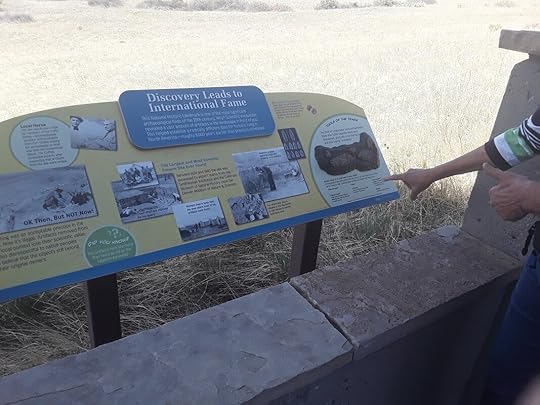 There is not much to see at the Lindenmeier Site. A short paved trail leads to a covered overlook where visitors look out over the arroyo in which the excavations have occurred, but they are either hidden from view or so carefully reburied that they are not visible. The weather was cooler and wetter during the period when the Folsom men inhabited it, but it is still easy to look over the vastness of the rolling hills and envision what life might have been like so many millennia ago.
There is not much to see at the Lindenmeier Site. A short paved trail leads to a covered overlook where visitors look out over the arroyo in which the excavations have occurred, but they are either hidden from view or so carefully reburied that they are not visible. The weather was cooler and wetter during the period when the Folsom men inhabited it, but it is still easy to look over the vastness of the rolling hills and envision what life might have been like so many millennia ago. Soapstone Prairie has multiple trails for hiking, biking and horseback riding and is open for visitation from March 1 until November 30 each year. It is a habitat for bison, black-footed ferrets, pronghorn antelopes, and other native species.
https://fortcollinsimages.wordpress.com/2017/04/02/lindenmeier-a-folsom-man-site/
https://www.fcgov.com/naturalareas/finder/soapstone
 In the Shadow of Sunrise is an historical novel set during the Folsom Period. The characters in the novel shelter every winter in the San Luis Valley, but during the summers they go on long migrations, following the herds and collecting suitable rocks for making spear points and other tools. While these characters do not visit the Linenmeier Site in my story, they would have done so in other years, and some of the people who lived at this site would have met my characters at other sites that they visited. The information available about this site did a lot to inform how I structured my story. Jennifer Bohnhoff is a former middle school and high school history and language arts teacher. She lives in the mountains of central New Mexico and write historical and contemporary fiction for middle grade through adult readers. She is available to lecture on the history behind her stories.
In the Shadow of Sunrise is an historical novel set during the Folsom Period. The characters in the novel shelter every winter in the San Luis Valley, but during the summers they go on long migrations, following the herds and collecting suitable rocks for making spear points and other tools. While these characters do not visit the Linenmeier Site in my story, they would have done so in other years, and some of the people who lived at this site would have met my characters at other sites that they visited. The information available about this site did a lot to inform how I structured my story. Jennifer Bohnhoff is a former middle school and high school history and language arts teacher. She lives in the mountains of central New Mexico and write historical and contemporary fiction for middle grade through adult readers. She is available to lecture on the history behind her stories.The booklink in the above blog is for Bookshop.org, an online bookseller that gives 75% of its profits to independent bookstores, authors, and reviewers. If you click through my book lists and make a purchase on Bookshop.org, I will receive a commission, and Bookshop.org will give a matching commission to independent booksellers. But if you’re not looking to buy, ask your local library for a copy, and request that they buy one if they haven't already.
January 25, 2025
The Lindenmeier Site
 The Soapstone Prairie Natural Area is in central Colorado, just south of the Wyoming border. It has within it an archeological site that few know about, even though it is very important to our understanding of man in the Americas. The Lindenmeier Folsom Site is one of the hidden gems of American Prehistory.
The Soapstone Prairie Natural Area is in central Colorado, just south of the Wyoming border. It has within it an archeological site that few know about, even though it is very important to our understanding of man in the Americas. The Lindenmeier Folsom Site is one of the hidden gems of American Prehistory.
 point from the Lindenmeier Site, 1934 Folsom Man is the name given to a group of Paleo-Indian nomadic hunters who roamed throughout Central North America between approximately 9,000 BC and 4,000 BC. They are identified by their stone points, which have a distinct concavity on one side.
point from the Lindenmeier Site, 1934 Folsom Man is the name given to a group of Paleo-Indian nomadic hunters who roamed throughout Central North America between approximately 9,000 BC and 4,000 BC. They are identified by their stone points, which have a distinct concavity on one side.Folsom Man is named after the small town of Folsom, New Mexico, In 1908, a devastating flood unearthed bison bones that were exceedingly large. It wasn’t until 1925, when scientists finally investigated the site, that stone points were found with the bones. The bones were determined to be those of bison antiquus, an ancestor of the modern bison that had died out approximately 10,000 years ago.
 Bison Antiquus. They were 25-30% larger than present day bison. Prior to the investigation of the Folsom Site, scientists believed that man had only been in North America for approximately 5,000 years.
Bison Antiquus. They were 25-30% larger than present day bison. Prior to the investigation of the Folsom Site, scientists believed that man had only been in North America for approximately 5,000 years. The Folsom Site is just a kill site. It contains bones and stone points, but there is no evidence of habitation, no campfires, no other tools or implements. Although it proved that man was in the Americas much earlier than previously supposed, it shed little light on who these people were. In 1924, three amateur archaeologists, A. Lynn Coffin, his father, Judge Claude C. Coffin, and their friend, C. K. Collins were wandering through a ranch owned by William Lindenmeier, Jr.. They were walking through an arroyo when they discovered some fluted points that were very different from the more abundant and smaller arrow points they usually found. The points were some fifteen feet below the surface. That depth suggested that they were very old. They called in the Judge’s brother, Major Roy G. Coffin, who persuaded Dr. Frank Roberts of the Smithsonian Institution to visit in 1934. The Smithsonian Institution, supported by the Colorado Museum of Natural History, excavated the site between 1935 and 1940. The Coffin brothers also did some excavating of their own. The well-preserved site is buried under twelve to fifteen feet of sediment and covered by layers of silts and clays slowly deposited by floods and windstorms over thousands of years. It contains clusters of stone and bone debris, strewn over at least a half-mile. These clusters represent work areas, where Folsom peoples manufactured projectile points, repaired or discarded broken tools, cooked their food, cleaned and transformed animal hides into leather, and manufactured clothing. Some archaeologists suggest that the clusters represent a single large camp simultaneously occupied by several large Folsom groups, each with twenty to forty members. These groups may have come together for a rendezvous or trade fair. Other archaeologists believe the clusters were laid down by a single group that returned year after year, generation after generation. Either way, the Lindemeier Site is the largest Folsom site yet found. It is still being excavated, and its secrets revealed.
 While the original Folsom site provided no tools except points, the Lindenmeier site shows that the Paleo-indians referred to as Folsom People created many types and shapes of tools. In addition to spearheads, archaeologists found wedge shaped scrapers and other tools made for chopping, slicing and skinning the hides of the bison. They also found scored pieces of hematite which were used to extract red ochre, believed to be used to paint for their faces or for ceremonial purposes. Highly polished 1-2”discs inscribed with designs were found at the site and are the oldest artwork found in Colorado.
While the original Folsom site provided no tools except points, the Lindenmeier site shows that the Paleo-indians referred to as Folsom People created many types and shapes of tools. In addition to spearheads, archaeologists found wedge shaped scrapers and other tools made for chopping, slicing and skinning the hides of the bison. They also found scored pieces of hematite which were used to extract red ochre, believed to be used to paint for their faces or for ceremonial purposes. Highly polished 1-2”discs inscribed with designs were found at the site and are the oldest artwork found in Colorado.
The site is listed on the National Register of Historic Places and is designated a National Historic Landmark. Artifacts from the site are held by the Smithsonian Institution, the Denver Museum of Nature and Science, the Fort Collins Museum of Discovery, and in private collections.
 There is not much to see at the Lindenmeier Site. A short paved trail leads to a covered overlook where visitors look out over the arroyo in which the excavations have occurred, but they are either hidden from view or so carefully reburied that they are not visible. The weather was cooler and wetter during the period when the Folsom men inhabited it, but it is still easy to look over the vastness of the rolling hills and envision what life might have been like so many millennia ago.
There is not much to see at the Lindenmeier Site. A short paved trail leads to a covered overlook where visitors look out over the arroyo in which the excavations have occurred, but they are either hidden from view or so carefully reburied that they are not visible. The weather was cooler and wetter during the period when the Folsom men inhabited it, but it is still easy to look over the vastness of the rolling hills and envision what life might have been like so many millennia ago. Soapstone Prairie has multiple trails for hiking, biking and horseback riding and is open for visitation from March 1 until November 30 each year. It is a habitat for bison, black-footed ferrets, pronghorn antelopes, and other native species.
https://fortcollinsimages.wordpress.com/2017/04/02/lindenmeier-a-folsom-man-site/
https://www.fcgov.com/naturalareas/finder/soapstone
 In the Shadow of Sunrise is an historical novel set during the Folsom Period. The characters in the novel shelter every winter in the San Luis Valley, but during the summers they go on long migrations, following the herds and collecting suitable rocks for making spear points and other tools. While these characters do not visit the Linenmeier Site in my story, they would have done so in other years, and some of the people who lived at this site would have met my characters at other sites that they visited. The information available about this site did a lot to inform how I structured my story.
Jennifer Bohnhoff is a former middle school and high school history and language arts teacher. She lives in the mountains of central New Mexico and write historical and contemporary fiction for middle grade through adult readers. She is available to lecture on the history behind her stories.
In the Shadow of Sunrise is an historical novel set during the Folsom Period. The characters in the novel shelter every winter in the San Luis Valley, but during the summers they go on long migrations, following the herds and collecting suitable rocks for making spear points and other tools. While these characters do not visit the Linenmeier Site in my story, they would have done so in other years, and some of the people who lived at this site would have met my characters at other sites that they visited. The information available about this site did a lot to inform how I structured my story.
Jennifer Bohnhoff is a former middle school and high school history and language arts teacher. She lives in the mountains of central New Mexico and write historical and contemporary fiction for middle grade through adult readers. She is available to lecture on the history behind her stories.
The booklink in the above blog is for Bookshop.org, an online bookseller that gives 75% of its profits to independent bookstores, authors, and reviewers. If you click through my book lists and make a purchase on Bookshop.org, I will receive a commission, and Bookshop.org will give a matching commission to independent booksellers. But if you’re not looking to buy, ask your local library for a copy, and request that they buy one if they haven't already.
January 18, 2025
The Long Road from Kid to President
 One of the first books I read this year was Doris Kearns Goodwin's The Leadership Journey: How Four Kids Became President. In this, her first book written specifically for juvenile readers, Goodwin analyzes how the childhoods of four men: Abraham Lincoln, Teddy and Franklin Roosevelt, and Lyndon Johnson, shaped their presidencies.
One of the first books I read this year was Doris Kearns Goodwin's The Leadership Journey: How Four Kids Became President. In this, her first book written specifically for juvenile readers, Goodwin analyzes how the childhoods of four men: Abraham Lincoln, Teddy and Franklin Roosevelt, and Lyndon Johnson, shaped their presidencies.Doris Kearns Goodwin is a brilliant woman and an engaging writer who has spent considerable time researching these four men. Her first book was Lyndon Johnson and the American Dream. After that, she published the Pulitzer Prize–winning No Ordinary Time: Franklin and Eleanor Roosevelt: The Homefront in World War II. She earned the Lincoln Prize for Team of Rivals , which became the basis for Steven Spielberg’s film Lincoln, and the Carnegie Medal for The Bully Pulpit , about the friendship between Theodore Roosevelt and William Howard Taft. Goodwin looked at all four men in her bestselling book Leadership: In Turbulent Times, which she went on to produce when it became a History Channel docuseries on Abraham Lincoln, Theodore Roosevelt, and Franklin Roosevelt. There is no question that she is well qualified to introduce these four famous men to younger readers. She knows these men intimately, including all the small stories that make them human and understandable.
The subtitle of this books is How Four Kids Became President, and I think this book would have been more satisfying for its intended audience if Goodwin had stopped right there. However, Goodwin continues on through each presidency, and the result is a book that is rather lengthy for middle grade readers. At 360 pages, it’d be quite a slog for most kids ages 8-12. To me, this is more a good overview for high school libraries or middle schools who do biography projects about political figures, or for adults who want an easy-to-read overview.Would you like to have my gently used copy? It's an ARC, and does not have the fully complete illustrations. I will be giving it away in early February, and if you'd like to be considered, please leave a comment on this blog.
January 12, 2025
Ancient Footprints Provide a Look at Life Long Ago
White Sands National Monument, in southern of New Mexico hasgiven scientists a unique view into the lives of people living long ago. Here,amid the pristine, white gypsum sand dunes that surrounded an ancient lake, scientistshave discovered the footprints of a woman and child who were crossing thesands. They have also found footprints from a hunt involving ancient humanbeings and a large prehistoric sloth. Both discoveries are extremely rare and couldchange our understanding of how long ago people were in the area and how they interactedwith large animals.

The footprints of the woman and child are part of what isconsidered the longest preserved "trace" of a person's fossilizedfootprints. Found on the plateau of a dried-up untouched lake bed, they extendfor almost a full mile. The area also has hundreds of thousands of footprintsof various ice age animals, including Columbian mammoths, giant sloths,sabertoothed cats, dire wolves, and giant bison.
The reason researchers believe that the person who crossedthe plateau was a woman is because of the size of her feet. A second set ofmuch smaller footprints amble about, sometimes disappearing and reappearingsome distance away. This indicates that the woman was traveling with a smallchild who sometimes walked and sometimes was carried.
The woman seems to have been in a hurry to get somewhere. Scientistscame to this conclusion based on the distance between the prints. The womanseems to have been walking at 1.7 meters per second, which is much faster than theaverage relaxed walking speed of between 1.2 and 1.5 meters per second. Hertracks, unlike the meandering smaller tracks, follow a straight line, indicatingthat she was traveling to a specific place, and that she knew where she wasgoing. Scientists say that a second set of tracks moving in the oppositedirection are also hers, indicating that hours later, she returned the sameway, but without the child.


A second set of tracks tells an even more interesting story,with more graphic details. Researchers have found more than 100 footprintsdating back between 11,000 and 15,000 years ago that seem to show humansfollowing, and perhaps hunting, a giant ground sloth. The animals, which disappearedabout 11,000 years ago, could reach the size of an elephant. Although thedistance between steps for a giant sloth is greater than that of a human step,the footprints show that the human hunters were following the sloth, sometimes walkingdirectly in the giant beast’s footsteps.
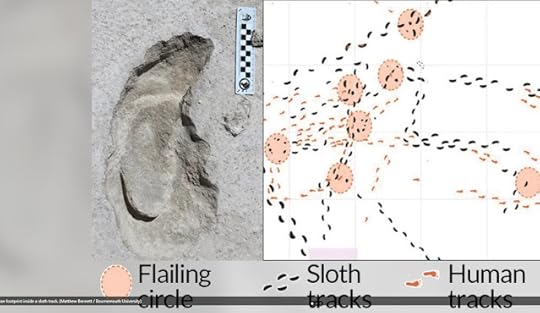
In some places, the human footprints appear close to thesloth’s markings, and one human appears to have gotten up on tip-toe very closeto the animal. The sloth, then, appears to have suddenly changed direction, andresearchers suggest that it stood up on its back legs and flailed about withits front legs in order to defend itself.
Matthew Bennett, the lead writer of a recent report on thediscovery that appeared in the scientific publication Science Advances saysthat hunting such a large animal "would have come with huge amounts ofrisk." The geology professor from Bournemouth University in England hasstudied these tracks and others, and speculates that they can help prove whetheror not early men played a role in the eradication of mega fauna at the end ofthe last Ice Age.
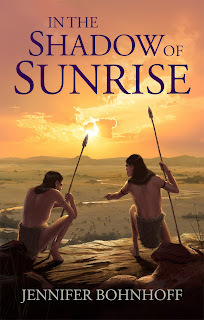
My novel, In the Shadow of Sunrise, tells the story of EarthShadow, a handicapped boy who goes on his first Walk Around, where he has thechance to prove his manhood. By the time that Earth Shadow walked along LakeLucero, a thousand years had passed, and with it, most of the megafauna thatroamed the plains of North America. Earth Shadow is a member of the Folsomculture, and the only large beasts left are the Bison Antiquus, an early, andmuch larger form of the American Bison that continues to live on the greatplains. Earth Shadow recognizes that the footprints he sees are old, but hedoesn’t know how old. He must rely on the stories of his people.
Recently, scientists found seeds from the aquatic plant Ruppiacirrhosa in the same levels of sand as the human footprints and subjectedthem to radiocarbon dating. The procedures produced dates between 23,000 and21,000 years ago. Although these ages mighthave been skewed by potentially old carbon reservoirs, it might indicate thathumans inhabited North America far longer than has been previously supposed.
Jennifer Bohnhoff left teaching English and History at the middle school level to become a full time teacher. Her latest book, In the Shadow of Sunrise, tells the story of a handicapped boy on the cusp of adulthood and is based on extensive research into the Folsom Period in what is now Colorado, New Mexico, and Texas. It will be published by Kinkajou Press, a division of Artemesia Publishing in April of 2025 and is currently available as a preorder through Amazon, Bookshop, and other online booksellers, as well as directly from the author.
January 5, 2025
Telescoping Distance and Time
 If you’ve lived in a place with sweeping, wide vistas, you understand that objects can appear much closer than they actually are. Here in New Mexico, where the air is thin and dry, it’s not uncommon to see mountain peaks that are well over a hundred miles distant. From my living room, South Mountain looks like an easy walk, when it is really a good twenty miles away.
If you’ve lived in a place with sweeping, wide vistas, you understand that objects can appear much closer than they actually are. Here in New Mexico, where the air is thin and dry, it’s not uncommon to see mountain peaks that are well over a hundred miles distant. From my living room, South Mountain looks like an easy walk, when it is really a good twenty miles away.

Charles Dickens experienced this when he visited the Alps in September of 1846. The individual mountain peaks were so large that they fooled the eye into believing they were much closer than they actually were. In his novel Little Dorrit, he begins Chapter 1 of Book 2 by describing this phenomena:
In the autumn of the year, Darkness and Night were creeping up to the highest ridges of the Alps. . . . The air had been warm and transparent through the whole of the bright day. Shining metal spires and church-roofs, distant and rarely seen, had sparkled in the view; and the snowy mountain-tops had been so clear that unaccustomed eyes, cancelling the intervening country, and slighting their rugged height for something fabulous, would have measured them as within a few hours’ easy reach. Mountain-peaks of great celebrity in the valleys, whence no trace of their existence was visible sometimes for months together, had been since morning plain and near in the blue sky. And now, when it was dark below, though they seemed solemnly to recede, like specters who were going to vanish, as the red dye of the sunset faded out of them and left them coldly white, they were yet distinctly defined in their loneliness, above the mists and shadows.
 I think reading historical fiction can do the same thing for events long distant. As we read what it was like in long ago times, the events draw nearer to us, the people more real. We live and breathe the experience as if it were in our own time, and we realize that we are much closer to these ancient peoples than we believed. Jennifer Bohnhoff is a former middle school and high school history and language arts teacher. She lives in the mountains of central New Mexico and write historical and contemporary fiction for middle grade through adult readers. She is available to lecture on the history behind her stories.
I think reading historical fiction can do the same thing for events long distant. As we read what it was like in long ago times, the events draw nearer to us, the people more real. We live and breathe the experience as if it were in our own time, and we realize that we are much closer to these ancient peoples than we believed. Jennifer Bohnhoff is a former middle school and high school history and language arts teacher. She lives in the mountains of central New Mexico and write historical and contemporary fiction for middle grade through adult readers. She is available to lecture on the history behind her stories. January 4, 2025
Telescoping Distance and Time
 If you’ve lived in a place with sweeping, wide vistas, you understand that objects can appear much closer than they actually are. Here in New Mexico, where the air is thin and dry, it’s not uncommon to see mountain peaks that are well over a hundred miles distant. From my living room, South Mountain looks like an easy walk, when it is really a good twenty miles away.
If you’ve lived in a place with sweeping, wide vistas, you understand that objects can appear much closer than they actually are. Here in New Mexico, where the air is thin and dry, it’s not uncommon to see mountain peaks that are well over a hundred miles distant. From my living room, South Mountain looks like an easy walk, when it is really a good twenty miles away.
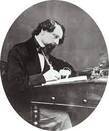 Charles Dickens experienced this when he visited the Alps in September of 1846. The individual mountain peaks were so large that they fooled the eye into believing they were much closer than they actually were. In his novel Little Dorrit, he begins Chapter 1 of Book 2 by describing this phenomena:
Charles Dickens experienced this when he visited the Alps in September of 1846. The individual mountain peaks were so large that they fooled the eye into believing they were much closer than they actually were. In his novel Little Dorrit, he begins Chapter 1 of Book 2 by describing this phenomena: In the autumn of the year, Darkness and Night were creeping up to the highest ridges of the Alps. . . . The air had been warm and transparent through the whole of the bright day. Shining metal spires and church-roofs, distant and rarely seen, had sparkled in the view; and the snowy mountain-tops had been so clear that unaccustomed eyes, cancelling the intervening country, and slighting their rugged height for something fabulous, would have measured them as within a few hours’ easy reach. Mountain-peaks of great celebrity in the valleys, whence no trace of their existence was visible sometimes for months together, had been since morning plain and near in the blue sky. And now, when it was dark below, though they seemed solemnly to recede, like specters who were going to vanish, as the red dye of the sunset faded out of them and left them coldly white, they were yet distinctly defined in their loneliness, above the mists and shadows.
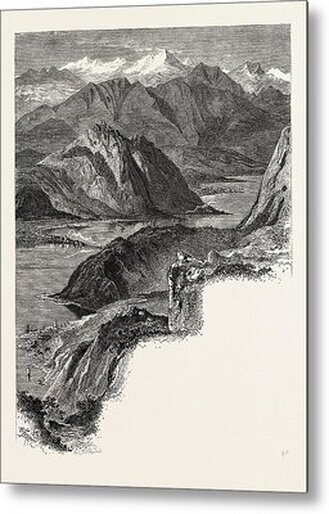 I think reading historical fiction can do the same thing for events long distant. As we read what it was like in long ago times, the events draw nearer to us, the people more real. We live and breathe the experience as if it were in our own time, and we realize that we are much closer to these ancient peoples than we believed.
I think reading historical fiction can do the same thing for events long distant. As we read what it was like in long ago times, the events draw nearer to us, the people more real. We live and breathe the experience as if it were in our own time, and we realize that we are much closer to these ancient peoples than we believed. Jennifer Bohnhoff is a former middle school and high school history and language arts teacher. She lives in the mountains of central New Mexico and write historical and contemporary fiction for middle grade through adult readers. She is available to lecture on the history behind her stories.
December 30, 2024
New Years Traditions

Last year, one of my sons noted that, other than watching the ball drop in Times Square, there were really no New Year’s traditions. I told him he was wrong, and to prove it (and to get to bed at a decent time!) we didn’t wait up for New York’s new year, but watched the fireworks erupt around the London Eye. Happy New Year, nice and early! Fireworks, champagne, and a kiss might be common worldwide, but here are some other traditions from around the world that you might want to try this year.
 Haruo.takagi, CC BY-SA 4.0 , via Wikimedia CommonsFireworks are noisy, but they aren’t the only sound that heralds the new year. In many places, people bang pots and pans as the year turns. In Japan, Buddhist temples ring bells 108 times, once for each of the earthly desires. With each toll, another desire is eliminated so that listeners begin the new year afresh. This tradition is called Joya no Kane, which Japan Today explains means “to throw away the old and move on to the new”: literally ringing out the old, ringing in the new!
Haruo.takagi, CC BY-SA 4.0 , via Wikimedia CommonsFireworks are noisy, but they aren’t the only sound that heralds the new year. In many places, people bang pots and pans as the year turns. In Japan, Buddhist temples ring bells 108 times, once for each of the earthly desires. With each toll, another desire is eliminated so that listeners begin the new year afresh. This tradition is called Joya no Kane, which Japan Today explains means “to throw away the old and move on to the new”: literally ringing out the old, ringing in the new!
Many traditions involve food, especially round food since the shape symbolizes prosperity. In the Philippines, people set out 12 round fruits to symbolize twelve months of prosperity. Spaniards and Italians pop 12 grapes or raisins into their mouths, one for each chime of the clock marking midnight. In Greece, families hang either an onion or pomegranate on their doors as a symbol of good health, fertility, and longevity. The French welcome the New Year with a stack of pancakes, and people in the Netherlands eat doughnuts and ring-shaped sweet breads.

© Alice Wiegand
But not all New Years foods are round. For good luck, Germans celebrate with marzipan that’s been shaped into a pig and the Japanese eat prawns, which are believed to bring a long life, and herring roe, which is supposed to boost fertility. The Estonians have many feasts on New Year’s Eve, believing that a person gains the strength of a man with each meal consumed. In the Southern part of the U.S., people eat collard greens, whose color symbolizes money, and black-eyed peas for luck and prosperity.
Other New Year’s traditions involve movement. Many people go on New Year’s walks or runs, often the first step in
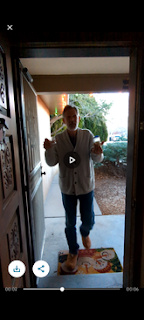
fulfilling one’s resolutions. In Scotland, people observe “first footing,” carefully planning who should be the first to enter the home after midnight. If the first visitor is a tall, dark-haired male bringing pieces of coal, shortbread, salt, a black bun and whiskey, prosperity is assured. One of my friends actually tried this one out last year. Danes literally “jump” into the new year. They leap off chairs or couches when midnight arrives. In Brazil, where revelers wear white to welcome the New Year, they enter the ocean and jump over seven waves, then walk backwards until they are back on dry land. And that ball drop in New York City’s Times Square? It’s been going on since 1907. According to Times Square’s official website, hundreds of thousands of people pack Times Square to watch the ball drop, and more than one billion other’s watch on TV.
Whatever traditions you and your loved ones follow, here's wishing you a prosperous and safe 2025.

Jennifer Bohnhoff is a writer who lives in the central mountains of New Mexico and writes historical and contemporary fiction for middle school through adult readers. She personally thinks the best way to assure a good new year is to buy a new book, preferably one of hers. If you'd like to learn more about her, check out her website.
December 29, 2024
New Years Traditions
 Last year, one of my sons noted that, other than watching the ball drop in Times Square, there were really no New Year’s traditions. I told him he was wrong, and to prove it (and to get to bed at a decent time!) we didn’t wait up for New York’s new year, but watched the fireworks erupt around the London Eye. Happy New Year, nice and early! Fireworks, champagne, and a kiss might be common worldwide, but here are some other traditions from around the world that you might want to try this year.
Last year, one of my sons noted that, other than watching the ball drop in Times Square, there were really no New Year’s traditions. I told him he was wrong, and to prove it (and to get to bed at a decent time!) we didn’t wait up for New York’s new year, but watched the fireworks erupt around the London Eye. Happy New Year, nice and early! Fireworks, champagne, and a kiss might be common worldwide, but here are some other traditions from around the world that you might want to try this year. 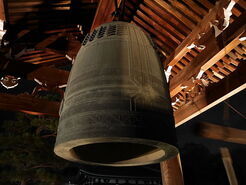 Haruo.takagi, CC BY-SA 4.0 , via Wikimedia Commons Fireworks are noisy, but they aren’t the only sound that heralds the new year. In many places, people bang pots and pans as the year turns. In Japan, Buddhist temples ring bells 108 times, once for each of the earthly desires. With each toll, another desire is eliminated so that listeners begin the new year afresh. This tradition is called Joya no Kane, which Japan Today explains means “to throw away the old and move on to the new”: literally ringing out the old, ringing in the new!
Haruo.takagi, CC BY-SA 4.0 , via Wikimedia Commons Fireworks are noisy, but they aren’t the only sound that heralds the new year. In many places, people bang pots and pans as the year turns. In Japan, Buddhist temples ring bells 108 times, once for each of the earthly desires. With each toll, another desire is eliminated so that listeners begin the new year afresh. This tradition is called Joya no Kane, which Japan Today explains means “to throw away the old and move on to the new”: literally ringing out the old, ringing in the new!Many traditions involve food, especially round food since the shape symbolizes prosperity. In the Philippines, people set out 12 round fruits to symbolize twelve months of prosperity. Spaniards and Italians pop 12 grapes or raisins into their mouths, one for each chime of the clock marking midnight. In Greece, families hang either an onion or pomegranate on their doors as a symbol of good health, fertility, and longevity. The French welcome the New Year with a stack of pancakes, and people in the Netherlands eat doughnuts and ring-shaped sweet breads.
 © Alice Wiegand But not all New Years foods are round. For good luck, Germans celebrate with marzipan that’s been shaped into a pig and the Japanese eat prawns, which are believed to bring a long life, and herring roe, which is supposed to boost fertility. The Estonians have many feasts on New Year’s Eve, believing that a person gains the strength of a man with each meal consumed. In the Southern part of the U.S., people eat collard greens, whose color symbolizes money, and black-eyed peas for luck and prosperity.
© Alice Wiegand But not all New Years foods are round. For good luck, Germans celebrate with marzipan that’s been shaped into a pig and the Japanese eat prawns, which are believed to bring a long life, and herring roe, which is supposed to boost fertility. The Estonians have many feasts on New Year’s Eve, believing that a person gains the strength of a man with each meal consumed. In the Southern part of the U.S., people eat collard greens, whose color symbolizes money, and black-eyed peas for luck and prosperity. 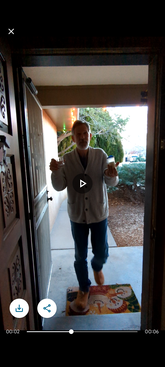 Another tradition is beginning the year with a clean sweep, literally. In Scotland, this is known as the redding of the house. Everything, from the cabinets to the front door is cleaned, with the fireplace getting special attention. In Cuba, people symbolically mop up bad spirits and negative energy and toss them right out the front door along with the dirty water during the countdown to midnight. The Irish also start the year with a spotless, freshly cleaned home, and set a place at the dinner table for any loved ones who died in the past year.
Another tradition is beginning the year with a clean sweep, literally. In Scotland, this is known as the redding of the house. Everything, from the cabinets to the front door is cleaned, with the fireplace getting special attention. In Cuba, people symbolically mop up bad spirits and negative energy and toss them right out the front door along with the dirty water during the countdown to midnight. The Irish also start the year with a spotless, freshly cleaned home, and set a place at the dinner table for any loved ones who died in the past year.
Other New Year’s traditions involve movement. Many people go on New Year’s walks or runs, often the first step in fulfilling one’s resolutions. In Scotland, people observe “first footing,” carefully planning who should be the first to enter the home after midnight. If the first visitor is a tall, dark-haired male bringing pieces of coal, shortbread, salt, a black bun and whiskey, prosperity is assured. One of my friends actually tried this one out last year.
Danes literally “jump” into the new year. They leaps off chairs or couches to leap off when midnight arrives. In Brazil, where revelers wear white to welcome the New Year, they enter the ocean and jump over seven waves, then walk backwards until they are back on dry land.
And that ball drop in New York City’s Times Square? It’s been going on since 1907. According to Times Square’s official website, hundreds of thousands of people pack Times Square to watch the ball drop, and more than one billion other’s watch on TV.
Whatever traditions you and your loved ones follow, here's wishing you a prosperous and safe 2025.
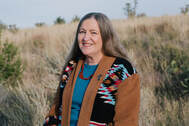 Jennifer Bohnhoff is a writer who lives in the central mountains of New Mexico and writes historical and contemporary fiction for middle school through adult readers. She personally thinks the best way to assure a good new year is to buy a new book, preferably one of hers. If you'd like to learn more about her, check out her website.
Jennifer Bohnhoff is a writer who lives in the central mountains of New Mexico and writes historical and contemporary fiction for middle school through adult readers. She personally thinks the best way to assure a good new year is to buy a new book, preferably one of hers. If you'd like to learn more about her, check out her website.
December 26, 2024
Ochre: An Ancient and Powerful Color
Humans have been engaging in art for a long, long time. Oneof the earliest colors that these artists used is a vibrant red called ochre. Ancientpeople used it for painting walls, and possibly their skin and clothes. Thefact that they often covered burials with ochre suggests they may have believedit to have magical properties.
 Marco Almbauer, CC BY-SA 3.0
Marco Almbauer, CC BY-SA 3.0 <https://creativecommons.org/licenses/...,
via Wikimedia CommonsOchre(pronounced OAK-er) is a soft, clay-like rock that is pigmented by hematite, areddish mineral that contains oxidized iron. It can be ground and mixed withwater to make a paint. Since ochre is a mineral, it doesn’t fade or decay with time,allowing its vibrant color to last over the millennia.
Theuse of ochre is even older than man. A Homo erectus site in Kenya calledGnJh-03 provides the earliest evidence of ancient humans using ochre. Archaeologistsfound about 70 pieces of ochre weighing about 11 pounds at this site, whichdates to about 285,000 years ago.
At an early Neanderthal site in the Netherlands called Maastricht-Belvédère,archaeologists excavated small concentrates of ochre, which they believe was powderedand mixed it with water so that they could paint their skin or clothing.
LaPasiega, a cave in northern Spain, has ochre paintings, including this one of ahorse. The paintings are estimated to date to at least 64,000 years ago and itis believed they were created by Neanderthals. Lawrence Straus, a distinguishedprofessor emeritus of anthropology at the University of New Mexico disagreeswith both the dating and the attribution of the paintings, arguing that Neanderthalsmight have used ochre to make non-representational paintings, such as lines anddots, but that it's debatable whether they made more complex cave paintings,such as illustrations of animals or human figures.
Gobierno de Cantabria, CC BY 3.0<https://creativecommons.org/licenses/..., via Wikimedia Commons
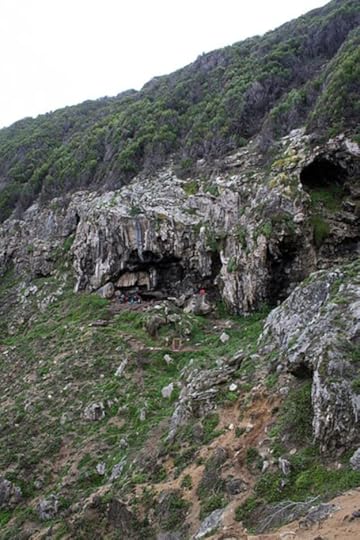 Vincent Mourre / Inrap, CC BY-SA 3.0
Vincent Mourre / Inrap, CC BY-SA 3.0 via Wikimedia Commons
Blombos Cave, in South Africa shows some of the earliestuses of ochre by modern humans. A small rock flake has a red ochre hashtag on itthat was probably painted about 73,000 years ago.
Ancient use of ochre is widespread, and is documented in Africa,Europe, the Middle East, Southeast Asia, Russia and Australia. When peoplecrossed over the Bering Strait land bridge from Siberia and East Asia to theAmericas, it appears they brought ochre with them. Once they were here, theycontinued to mine the soft stone. Powars II, a site in the southern RockyMountains of Wyoming, was first mined about 12,800 years ago. It is the onlyone of the five red- ochre quarries discovered in the Americas that is north ofMesoamerica.
Ochre was not only used for painting caves. One grave foundin Southern Wales, in the United Kingdom, in 1823 had a skeleton that had somuch ochre on it that archaeologists speculated that the skeleton must be theremains of an indecent, scarlet woman. It turns out that they were very wrong,and that the famous Red Lady of Paviland is actually the burial of a young manwho lived during the Paleolithic about 33,000 years ago. An Alaskan burial of two infants covered in ochre dates to about 11,500 years ago.
Ochremay have had practical applications as well. Some archaeologists argue that itwas as a sunscreen and to keep insects off the skin.Some archaeologists believe that because of its color, redochre is a symbol of blood and was used ceremonially for hunting success. Othersthink it was a symbol of life and fertility. Even today, the color red brings upstrong emotions. When someone says they are seeing red, it means they are veryangry. Red hearts are symbols of love. It’s no wonder that ochre has continuedto be used as a pigment throughout antiquity, medieval times, the Renaissance,and continues to be used today.

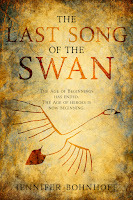 Jennifer Bohnhoff is an author of historical and contemporary fiction for adults and middle grade readers. Her novel, The Last Song of the Swan is a dual timeline story set in the modern Southwest and in what is now Denmark, during the late Ice Age, when Neanderthals and Modern Humans both lived in the area. This spring, In the Shadow of Sunrise will be published. It is a story about a young man ready to go through the ceremonies that will prove him a man, and it's set in the Southwest 11,000 years ago, during the Folsom Period. Both books feature the use of ochre in paintings, burials, and hunting ceremonies.
Jennifer Bohnhoff is an author of historical and contemporary fiction for adults and middle grade readers. Her novel, The Last Song of the Swan is a dual timeline story set in the modern Southwest and in what is now Denmark, during the late Ice Age, when Neanderthals and Modern Humans both lived in the area. This spring, In the Shadow of Sunrise will be published. It is a story about a young man ready to go through the ceremonies that will prove him a man, and it's set in the Southwest 11,000 years ago, during the Folsom Period. Both books feature the use of ochre in paintings, burials, and hunting ceremonies.
December 20, 2024
Christmas 1944
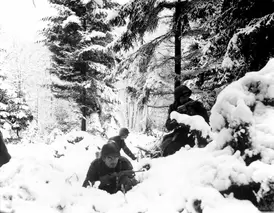
No one battling in Europe in 1944 knew that this would be the last Christmas of the war. Americans didn’t know they were halfway through the Battle of the Bulge, the major German offensive that had begun December 16 and would end late in January, 1945. This battle, also known as the Ardennes Offensive, raged throughout the densely forested Ardennes region between Belgium and Luxembourg during what was one of the area’s coldest winters on record. About 8 inches of snow lay on the on the ground, and the temperature averaged of 20 degrees Fahrenheit.
Christmas was definitely not celebrated in style among the troops. In front line hospitals, Bing Crosby’s “White Christmas” played on an old gramophone and champagne was served, but nearby, piles of undelivered Christmas cards and packages were drenched with gasoline and set on fire to keep them out of German hands. Years later, Lt. Robert I. Kennedy recalled his Christmas dinner he shared with three other soldiers:“One can of hamburger patties and one can of mashed potatoes so cold they were almost frozen. No one had any mess kits or any utensils, so each man reached dirty, bare hands into one can for one patty and with the other dirty hand for a fistful of mashed potatoes.”

 Life was a little better for Americans who had already been captured. At Stalag Luft III in Sagan, Poland, temperatures hovered just below 0°F, but at least the men were in barracks instead of foxholes. The American Red Cross had packed and shipped 75,000 Christmas parcels containing canned turkey, fruit cake, tobacco, games, and Christmas decorations during the summer of 1944. Kriegies, the English slang for the German Kriegsgefangenen or prisoner of war, used those packages to celebrate.
Life was a little better for Americans who had already been captured. At Stalag Luft III in Sagan, Poland, temperatures hovered just below 0°F, but at least the men were in barracks instead of foxholes. The American Red Cross had packed and shipped 75,000 Christmas parcels containing canned turkey, fruit cake, tobacco, games, and Christmas decorations during the summer of 1944. Kriegies, the English slang for the German Kriegsgefangenen or prisoner of war, used those packages to celebrate.The prisoners in Stalag Luft III wrote that they had a gigantic “bash,” and were allowed to roam the grounds. Alcohol, made by fermenting raisins from aid packages, flowed in several camps. Many camps had Christmas concerts and services. The Christmas pageant at Stalag Luft III was so well attended that not all of the 11,000 POWs were able to attend in the 700 seat auditorium, even though they gave multiple performances. German guards in Stalag VIIA gave their prisoners small Christmas trees from guards, which the men decorated with snowflakes cut from tin cans, lint, food labels, and nails.
 Donald G. Cassidy Collection (AFC/2001/001/1599), Veterans History Project, American Folklife Center, Library of CongressDonald G. Cassidy, who was a Technical Sergeant in the 570th Bomb Squadron, 390th Bomb Group, 8th Air Force, spent Christmas of 1944 in Stalag XVIIB, just outside of the village of Krems, Austria. When he’d first arrived, in December of 1943, he and the other prisoners each received their own Red Cross parcels. Eventually, the supplies dwindled. Guards explained that American planes were bombing the Red Cross supplies. They began dividing parcels between two men when they got them at all. To make up for the loss of parcels, the Germans gave the POWs soap on occasion. The POWs also got ersatz coffee, a coffee substitute made from the taproots of chicory, soybeans, barley, and grains and formed into bricks, and sauerkraut, but the POWs found both so bad tasting that they used it for fuel.
Donald G. Cassidy Collection (AFC/2001/001/1599), Veterans History Project, American Folklife Center, Library of CongressDonald G. Cassidy, who was a Technical Sergeant in the 570th Bomb Squadron, 390th Bomb Group, 8th Air Force, spent Christmas of 1944 in Stalag XVIIB, just outside of the village of Krems, Austria. When he’d first arrived, in December of 1943, he and the other prisoners each received their own Red Cross parcels. Eventually, the supplies dwindled. Guards explained that American planes were bombing the Red Cross supplies. They began dividing parcels between two men when they got them at all. To make up for the loss of parcels, the Germans gave the POWs soap on occasion. The POWs also got ersatz coffee, a coffee substitute made from the taproots of chicory, soybeans, barley, and grains and formed into bricks, and sauerkraut, but the POWs found both so bad tasting that they used it for fuel.
 Ministry of Information Photo Division Photographer, Public domain, via Wikimedia CommonsMeanwhile at home, families managed as best as they could. Rationing of sugar and butter made cookie making challenging. Many had to forego the Christmas turkey, since so much of the supply was sent overseas for the troops. Children’s toys were manufactured from wood and paper since metal, rubber, and rayon were all rationed for the war effort. Worst of all was the absence of so many men, and the fears that they might not come back at all, It’s no wonder that many of the songs released during the war, including “White Christmas” (1941), “I’ll Be Home for Christmas” (1943), and “Have Yourself a Merry Little Christmas” (1944) have a melancholy air to them.
Ministry of Information Photo Division Photographer, Public domain, via Wikimedia CommonsMeanwhile at home, families managed as best as they could. Rationing of sugar and butter made cookie making challenging. Many had to forego the Christmas turkey, since so much of the supply was sent overseas for the troops. Children’s toys were manufactured from wood and paper since metal, rubber, and rayon were all rationed for the war effort. Worst of all was the absence of so many men, and the fears that they might not come back at all, It’s no wonder that many of the songs released during the war, including “White Christmas” (1941), “I’ll Be Home for Christmas” (1943), and “Have Yourself a Merry Little Christmas” (1944) have a melancholy air to them.
 Jennifer Bohnhoff writes historical and contemporary fiction for middle grade through adult readers. Her novel, Code: Elephants on the Moon tells the story of a young French woman who joins the Resistance as D-Day approaches.
Jennifer Bohnhoff writes historical and contemporary fiction for middle grade through adult readers. Her novel, Code: Elephants on the Moon tells the story of a young French woman who joins the Resistance as D-Day approaches. 


